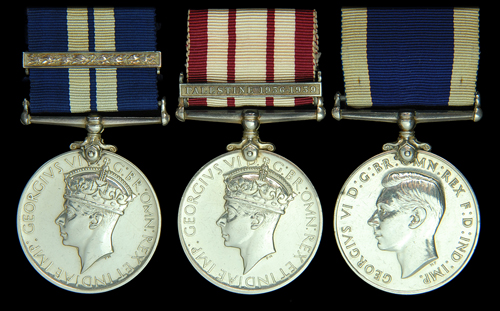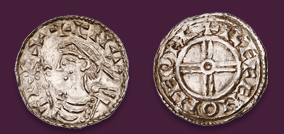
Auction: 8016 - Orders, Decorations, Medals & Militaria
Lot: 4
A Very Early and Scarce Second World War ´Anti-Submarine Duties´ D.S.M. and ´1940, Battle of Calabria´ Bar Group of three to Petty Officer T.W. Overall, Royal Navy a) Distinguished Service Medal, G.VI.R., with Second Award Bar (T.W. Overall. L.Sea. J.113336. H.M.S. Ilex.), officially engraved, it is not unusual for early D.S.M.s of this period to be engraved, for example Graf Spee awards were issued unnamed and some with year of issue only b) Naval General Service 1915-62, G.VI.R., one clasp, Palestine 1936-1939 (J.113336 T.W. Overall. L.S. R.N.) c) Naval Long Service & G.C., G.VI.R., 1st ´Ind: Imp:´ type (J.11336 T.W. Overall. A/P.O. H.M.S. Victory.), generally very fine or better (3) Estimate £ 2,400-2,800 D.S.M. London Gazette 1.1.1940 Thomas William Overall, Leading Seaman, H.M.S. Ilex ´´For outstanding zeal, proficiency, skill and energy in successfully combating submarines.´´ D.S.M. Second Award Bar London Gazette 11.9.1940 Leading Seaman Thomas William Overall, D.S.M., P/J.113336, H.M.S. Ilex. J.113336 Petty Officer Thomas William Overall, D.S.M., served in operations along, and off, the coast of Palestine with the Royal Navy prior to the outbreak of the Second World War, after which he continued his service with the Navy, in H.M.S. Ilex (Intrepid Class Destroyer); serving as a Leading Seaman in the latter he took part in Anti-Submarine duties during 1939, and on the 13th of October that year the Ilex in partnership with H.M.S Imogen attacked and sank the German submarine U-42, south west of Ireland; the following year as part of the Mediterranean Fleet (commanded by Admiral (later Viscount) Cunningham) the Ilex was employed on Convoy Escort duties; whilst covering a convoy from Malta to Alexandria Cunningham´´s main fleet (including the Ilex) engaged the Italian fleet for the first time off the coast of Calabria, 9.7.1940, ´´in the action which followed, the British were, on paper, superior in capital ships, of which they had three against two Italians. But the Royal Sovereign was too slow to keep her position in the line and the Malaya also never got within range. In cruisers and destroyers the Italians were greatly superior. The action consisted firstly of an unsuccessful attempt to slow down the enemy with torpedo-bombers from the aircraft carrier Eagle, then of a long-range gun duel. After the battleship Cesare had been hit the Italians turned away and retired under cover of a smoke screen, while skirmishes took place between the opposing destroyers. In the final phase there was heavy but ineffective bombing by Italian shore-based aircraft....... Admiral Cunningham pursued to the westward until evening when he was only twenty-five miles from the Calabrian coast; but the enemy made good his escape and the British fleet, still under bombing attack, steered firstly to the south of Malta and then after safe passage of the convoys had been assured, returned to its base at Alexandria´´ (History of The Second World War, The War at Sea, Vol. I, by Captain S.W. Roskill, D.S.C., R.N., refers); Overall received a Second Award Bar to his D.S.M. for his gallant conduct during the battle; ten days later the Ilex was again in action with the Italian fleet off Cape Spada, this time in conjunction with the Australian cruiser H.M.A.S. Sydney and four other British destroyers (H.M.S. Hasty, Havock, Hero and Hyperion); the British force was on a sweep in the Aegean when they were ordered to intercept two Italian cruisers which had been reported in the area; the Bartolomeo Colleoni was halted off Cape Spada, at the north-west tip of Crete, by Sydney´´s gunfire; she was finished off by torpedoes from the British destroyers; the other light cruiser Giovanni delle Bande Nere managed to escape.
Sold for
£4,600




